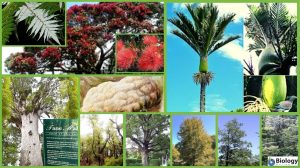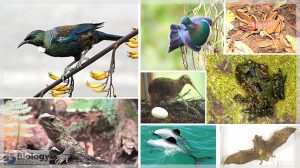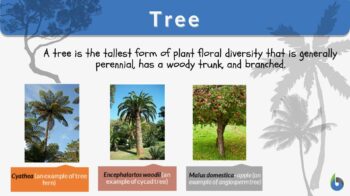
Tree
n., plural: trees
[triː]
Definition: tallest form of plant floral diversity that is generally perennial, woody and branched among other plant varieties.
Table of Contents
“The biological diversity is plenty if you look around yourself a little closely; with an eye for life!” … People often find it hard to recognize and identify biological diversity with precision because they lack the ability to categorize and sort biodiversity first. The basic rationale behind this is that when you sort and categorize different forms of biological organisms into groups, you use a set of pre-defined characteristic features and identification tags.
Just for example, in the megadiverse plant world, trees are just one type of floral diversity. Botanists and plant experts categorize flora based on their chosen characteristic features. Some like to categorize flora based on plant height; others choose to categorize flora based on the presence or absence of secondary growth. There is no “one” standout feature that can get consensus votes of all the Botanists to classify the plant diversity into tree and non-tree. When we look at how many trees there are in the world in totality, there can’t be a definite number to it, but only an estimate. Plant scientists lay their emphasis on forest covers and natural plant habitats more and less on the exact counting of trees.
Tree Definition
Based on the basic growth habit, plant scientists classify plants into herbs, shrubs, and trees. So, when asked about the definition of tree in biology, we can elaborate them as follows:
“A tree is the tallest form of plant floral diversity that is generally perennial, woody and branched among other plant varieties”.
If questioned, is a tree a plant? The answer is YES; a perennial plant! The origin of the word tree is from the Old English word “trēow, trēo”, which is further derived from a Germanic word “doru” meaning ‘wood, spear’ or “drus” meaning ‘oak’. In Botany, trees are different from herbs and shrubs based on these characters as listed in the table below:
Table 1: Characteristics of herbs, shrubs, and trees | |||
|---|---|---|---|
| Character | Herbs | Shrubs | Trees |
| Stems | Non-woody | Partially woody | Totally woody |
| Nature | Usually annual/biennials | Perennials | All perennial trees |
| Height | Smallest (usually <1metre) | Medium-sized (1-3 metres) | Tallest (>4 metres) |
| Branching | Not much | Moderately branched | Intensively branched |
| Root systems | Weak, can be easily uprooted | Moderately strong | Tightly bound to soil |
| Life span | Short (perishable ephemerals) | Longer than herbs, shorter than trees | Longest among others |
| Examples | Poppy, basil, grasses | Rose, jasmine, hibiscus | Mango, pine, apple |
A tree is the tallest form of plant floral diversity that is generally perennial, woody, and branched among other plant varieties. In botany, plants are classified as herbs, shrubs, or trees. Trees differ from herbs and shrubs in being woody, perennial, tall (>4 meters), intensively branched, tightly bound to the soil, and the longest plant variety. Examples of trees are mango trees, pine trees, and apple trees.

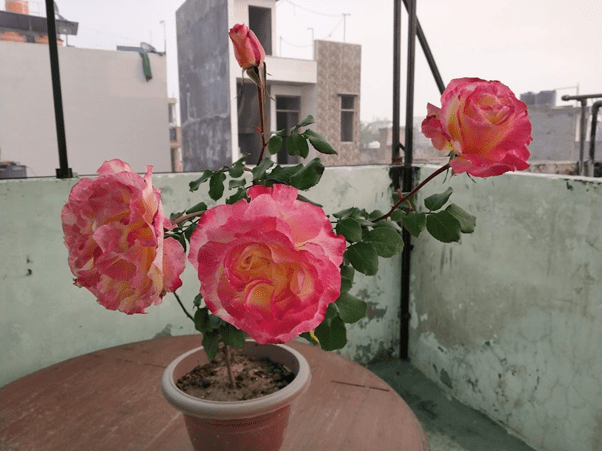
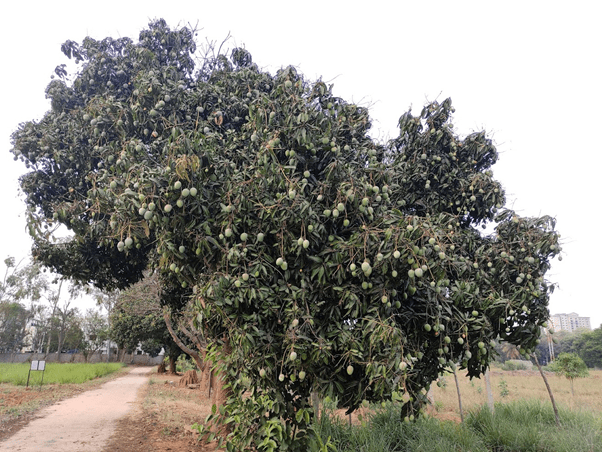
So, now when you’re asked to define a tree, you should be able to give the basic pointers about its nature like:
- Woody: Stems and roots show secondary growth.
- Perennial: Live for a good number of years (renew growth year after year). Although there are deciduous trees too that shed their leaves every season. So, when asked how do trees grow, there’s no one specific way, but generally, trees are perennial.
- Profusely branched: Branching happens high above the ground level and a certain level of canopy formation is there!
- Ubiquitous in nature: Spread around the globe across different ecosystems and habitats.
- Multifunctional: Produce oxygen, prevent soil erosion, contribute to ecosystem stability, yield products of importance to life (food, clothing, shelter, ecosystem services, etc.)
- Division of Kingdom Plantae containing trees: Pteridophytes, Gymnosperms, Angiosperms.
- An important point to note when we try to understand the meaning of a tree is that “tree is not a separate taxon”; meaning it’s not a specific taxonomic group per se. It’s just a category of plants based on some distinguishing features.
1. Members of various different taxa (Pteridophytes, Gymnosperms, Angiosperms) at the Division level can be examples of trees.
2. Members of various different taxa (Cyatheaceae, Pinaceae, Rutaceae) at the Family level can be examples of trees.
3. But trees aren’t a separate taxon themselves!
To learn more about “what a taxon is?”, read our article on TAXON here.
Classification of Trees
Just like there’s no one fixed, standout way to tell what a tree is or what a tree means, there’s no one definite way to define a group of trees. While some scientists prefer to sort them phylogenetically, others prefer to categorize them based on morphological and ecological habitat preferences. Let’s look at each of them one by one and decipher the diversity.
A. Phylogenetic classification
According to the phylogenetic concept, different types of trees can be divided into 3 major groups. These 3 groups are actually the 3 major lineages of vascular plants namely:
1. Pteridophyta Trees
Among the Pteridophytes, tree ferns are represented by 3 different orders namely:
- Cyatheales (with families Dicksoniaceae, Metaxyaceae, and Cibotiaceae)- small tree
- Polypodiales (with genus Tempskya– extinct!)
- Marattiales (with genus Psaronius– extinct!)
2. Gymnosperm Trees
Among the Gymnosperms, trees are represented by many different families some of which are:
- Cycadaceae (with cycads like Encephalartos woodii)
- Ginkgoaceae (much known Ginkgo biloba)
- Pinaceae (like fir, juniper, pine, etc.)
3. Angiosperm Trees
Among the Angiosperms, trees are mainly a part of dicots. Only a few monocots are trees; examples are the family Arecaceae (palms, coconut, etc.), Asparagaceae (yucca, dracaena tree), Asphodelaceae (aloe tree). Otherwise, the wide representation of angiosperm trees is from dicot families. Some examples are mango tree, cherry tree, apple tree.

B. Ecological and evolutionary classification
- In the evolutionary concept, a tree isn’t a distinct clade or unit. And neither can trees be called a primitive or advanced entity since both the most primitive plant families and the most advanced ones have tree species in them.
- In the ecological concept, trees are defined and understood by their physical appearance. Some species of plants that are “tree by definition” in some ecological setups/conditions are “shrubs by definition” in some other ecological setup. One same species can be both a tree and a shrub, but it depends on which ecological setup it’s growing and flourishing. Since environmental conditions modulate how a plant species grows and forms into an adult, therefore to decipher if a plant species is a tree or a shrub, you need to first know how that environmental setup molds the growth conditions for that particular species.
C. Popular classifications
There are several types of other classifications which are popular among plant scientists, learners, and enthusiasts. Let’s take a quick look at them.
- Evergreen vs. Deciduous Trees
Table 2: Evergreens vs. Deciduous Trees | ||
|---|---|---|
| Characteristics | Evergreen Trees | Deciduous Trees |
| Leaves | Keep leaves around the entire year | Shed their leaves |
| Size of leaves | Smaller | Larger |
| Requirement of nutrients | Less | More (needed for foliage renewal) |
| Tolerance for weather conditions | Less | More |
| Sensitivity of rainfall & temperature | Less | More |
| Grow in | Warm, tropical climate | Temperate climate |
| Examples | Most angiosperm trees | Coniferous trees like larch, angiosperm tree-like birch |

2. Softwood Trees vs. Hardwood Trees
Table 3: Softwood Trees vs. Hardwood Trees | ||
|---|---|---|
| Characteristics | Softwood Trees | Hardwood Trees |
| Basic group | Gymnosperms | Angiosperms |
| Nature of wood | Light, porous, less dense, easier to cut | Dense, less porous, heavier, doesn’t split |
| Cost in market | Cheaper | More expensive |
| Resistance to fire | Less resistant | More resistant |
| Xylem vessels present | No | Yes |
| Durability | Less | More |
| Growth of tree | Faster | Slower |
| Examples | Pine tree, Spruce tree | Maple tree, Teak tree |
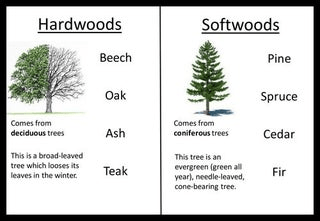
The Importance of Trees
Trees are important since they serve various functions in environmental stability, food and shelter provision to a variety of beings, ecological services to humans, and employment/financial support to sustain human lives. Let’s take a look at them under the various subheadings one by one.
Ecological importance
Why are trees important? Trees play varied roles of ecological importance ranging from environmental factors regulation like controlling floods, freshwater purification, regulation and modulation of Earth’s temperature, stabilization of surface soil layers, balancing air’s oxygen and carbon dioxide levels, improving the quality of air, provision of food and shelter to wildlife and ecological services to humankind. The different ecological roles that trees serve can be understood by the illustration below.

Economic importance
Trees provide a plethora of products of economic importance. Ranging from wood and lumber to essential oils and perfumes, trees contribute to the economy of a nation immensely. Look at the picture below to find out the many prospects humans use trees for!

Trees of special interest
Of the total land area of Earth, approximately a good 31% (~4.06 billion hectares) is totally covered by forests. This is according to the Global Forest Resources Assessment 2020 of FAO-2020. While trees cover a very good percentage amongst forests, trees are also there in the form of man-made plantations, urban parks, agricultural fields, natural swamps, mangroves, etc.
While all trees are special, some are a little more important because of the essence associated with them. Let’s discuss two of them to know what that “essence” is in tree biology…
1. SACRED GROVES
Sacred groves are tree communities or forests of importance to some indigenous communities. This could be due to some historic or spiritual or communal sentiments associated with the trees of groves. Sacred groves are treated as “living communities of trees” and revered hugely. Any sort of tree-logging or hunting activities are strictly prohibited in such tree communities. Even sapling trees in such groves are worshipped and can’t be uprooted. Some examples of sacred groves are:
a) Deodar Devban grove in Himachal Pradesh, India.
b) Umang Lai (literally, “Forest Deities”) in Manipur, India
c) Sacred groves of Sierra Leone in Ghana
d) Sacred groves of Oshogoo in Nigeria
e) Monastery groves in China (preserve Ginkgo biloba)

2. MANGROVES
Mangroves play an indispensable role in the proper natural functioning of the coasts of the world. Without mangroves, coastlines could have eroded away and life won’t have been sustained in or near the coasts. Mangroves forest trees are well-adapted to grow under “low-oxygen” conditions. One specific point to note here is that mangrove trees can grow only in “tropical to subtropical” areas/latitudes. They have zero tolerance for freezing temperatures of poles.
Some examples of mangroves trees around the globe are:
a) Rhizophora mangle – The red mangrove
b) Laguncularia racemosa – The white mangrove
c) Avicennia germinans – The black mangrove
d) Rhizophora mucronata – The loop-root mangrove
e) Avicennia marina – The grey mangrove

Tree Parts and Function
The various different parts of a tree with their functions can be understood by the table below. To state first, the different essential parts starting from down to up are roots, stem/trunk, leaves, buds, flowers, fruits and seeds.
Table 4: Parts of a tree and their functions | |
|---|---|
| Parts of Tree | Function or Role |
| Roots |
|
| Trunk (woody stem) |
|
| Leaves |
|
| Buds |
|
| Flowers |
|
| Fruits |
|
| Seeds |
|
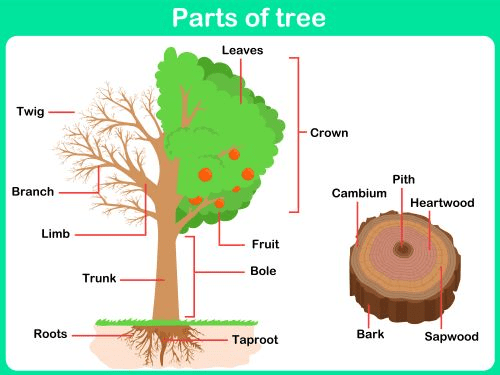
Tree Lines
By definition, tree lines are those edges of habitats where we can often see trees growing luxuriously. If we try to cite trees beyond the tree line, we fail to do so because those temperatures are beyond the tolerance levels of trees. Trees aren’t able to prosper beyond the tree lines because of the following reasons:
- Extremely cold temperatures
- Associated lack of available moisture
- Extreme snowpack
- Intolerance for non-physiological temperatures
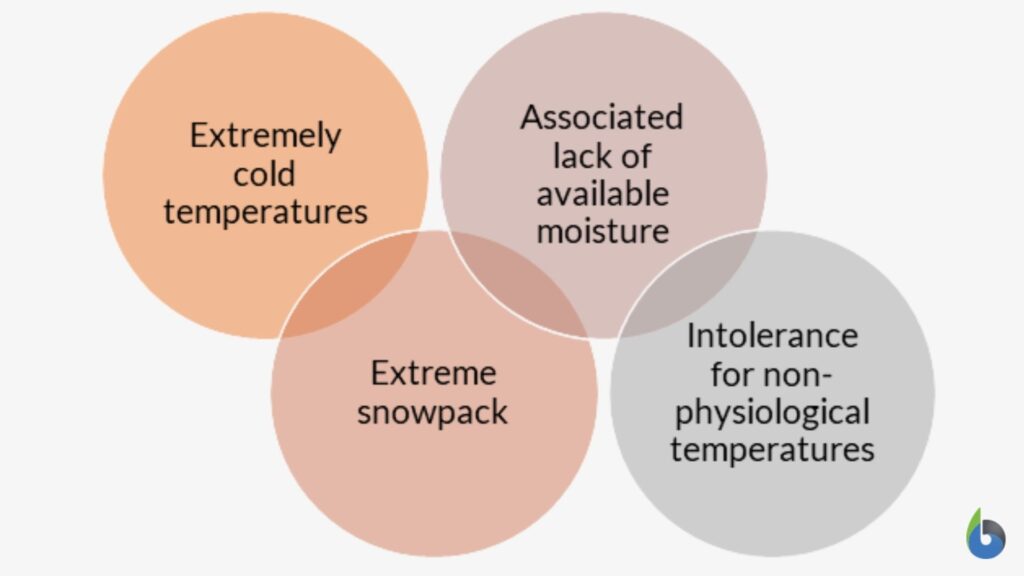
Adaptations
There are several adaptations in trees depending on the prevailing environmental conditions in the area where they are growing. To suit and gel well with those conditions, trees develop various morphological, physiological, and evolutionary adaptations. While some adaptations are general to all the parts of the trees (meaning they are common to the cells of all plant parts), while other adaptations are specific to some parts of the trees like leaves or trunk or roots.
Leaf adaptations
The various features of leaves that can vary and be fine-tuned by trees are:
- Chlorophyll content
- Leaf shape and size
- Location and size of chloroplasts
- Structure and size of stomata
- The thickness of leaf and wax coat
- Leaf angle of projection
- Number of veins in leaves
Examples of leaf adaptations:
1. In xeric conditions, leaves are modified to adapt to the lack of moisture content. Since the evaporation rates are high, leaves are reduced in size to spines. To minimize the water loss, this kind of adaptation is important as reducing the leaf area compensates for the less water availability. Stomata are reduced in size and number, the leaf surface is thickened, cuticle and wax deposition is higher. Tissues become mucilaginous (to maximize storage of available water).
2. Furthermore, some trees go to extreme levels of leaf adaptation as they entirely drop their leaves when extreme summers step in. Example: Red Buckeye Tree

3. Another example of xeric adaptation in leaves is the restriction of stomata in the Chinese Fir tree on the underside of the needle. Stomata have a characteristic “stomatal bloom”, which is a waxy white layer around the stomata. Purpose: Waterproofs the reduced needle-like leaves of Chinese fir tree and aids water conservation in the tree.
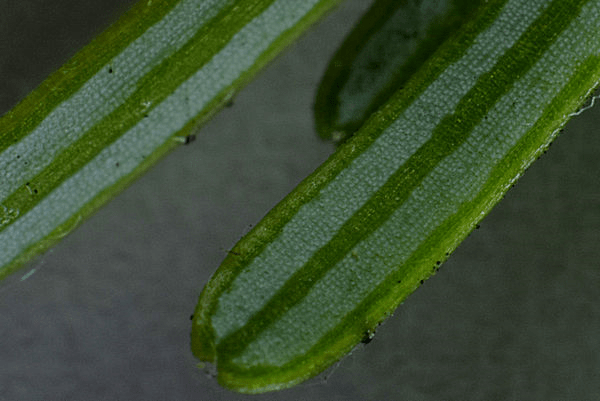
To learn more about various types of adaptations- structural, behavioral and physiological adaptations, read our article on Physiological adaptations.
Wood adaptations
Wood serves several essential functions in the life of a tree. From the provision of support to conduction of the water and nutrients to the transportation of food to the storage of carbohydrates, wood plays many roles that are basic to the life of a tree. It also plays indispensable roles in protection against pathogen attacks and many other defense roles. Wood is modified and adapted in different trees depending on the requirements of the species according to the environmental stresses.
The various features of wood that can be fine-tuned by the tree to make it the best suited for prevailing environmental stress are:
- The growth rate of wood cells
- Packing of the wood cells (loose/compact)
- Accumulation of resinous/gummy substances
- Wood rigidity (Nature and composition of cells)
- Vessel/Tracheid/Fibers Distribution, diameters, and frequency
- Percentage of lignification
- Percentages of cellulose and hemicellulose
Examples of wood adaptations:
1. Bristlecone pines (Pinus longaeva) are one of the oldest inhabitants of Earth. These trees have survived the test of time because they have certain adaptations in their various body parts that make them well-suited for extreme environmental conditions. One of the notable adaptations is the extremely dense and resin-loaded wood of these trees. This heaving loading of resins and gums makes the trees resistant to pathogen and microbial attack. Since the presence of resins makes the wood durable; trees longevity is sureshot! Additionally, this also helps in the retention of more moisture to trade over the deficit of water these trees face.
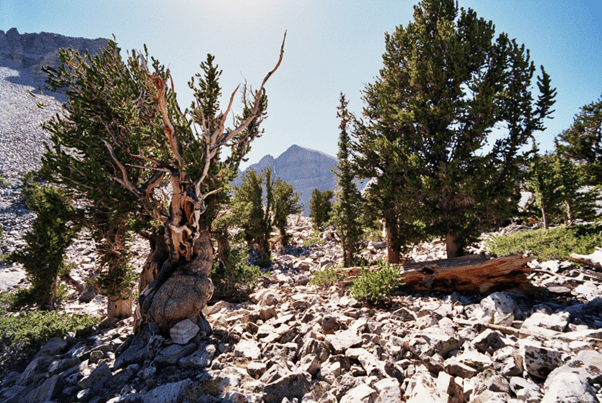

2. To cope up with the drought conditions, many tree species change their wood anatomy. Gymnosperm species like Pinus radiata and angiosperm species like Populus hybrids show an amazing diversity in their tracheary elements. Tracheary elements have mind-blowing plasticity if we look closely and compare among different plant lineages. Each such adaptation makes the particular tree species in the picture “the most suitable” for its habitat. This very complex system of wood in these species is for a perfect balance between optimum water conduction and to level out chances of failure during water deficit.

Interesting Facts About Trees
Thimmamma Marrimanu is a Ficus benghalensis tree specimen from Anantapur, Andhra Pradesh, India. This is a single tree specimen with a record of having the largest land area cover and canopy cover. The canopy cover is 2.19 hectares (5.41 acres), the largest in the world of any single tree. This is nearly equivalent to “3 soccer fields”. Now, your dilemma would be “how can one tree spread so wide????”
The answer to this is: Ficus benghalensis have “prop roots”, which are aerial adventitious roots growing from the horizontal branches to the ground, eventually turning into trunks. These provide extra support to the tree and help it survive for long years.
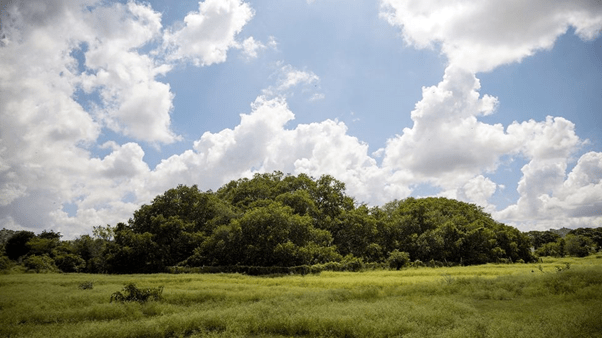
Sources:
1) Guinnessworldrecords.com
2) bbc.com
Try to answer the quiz below to check what you have learned so far about trees.
References
1. Tokuhisa J. (2013). “Tree definition”. Newton: Ask a Scientist.
2. Ehrenberg R. (2018). “What makes a tree a tree?”. Knowable Magazine. doi:10.1146/knowable-033018-032602.
3. Keslick J.A. (2004). “Tree Biology Dictionary”.
4. Liphschitz N., Waisel Y. (1982) Adaptation of plants to saline environments: salt excretion and glandular structure. In: Sen D.N., Rajpurohit K.S. (eds) Contributions to the ecology of halophytes. Tasks for vegetation science, vol 2. Springer, Dordrecht. https://doi.org/10.1007/978-94-009-8037-2_14
5. PLANT ADAPTATIONS TO HOT & DRY CONDITIONS (Xeric Adaptations)- https://txmn.org/alamo/files/2020/08/XericAdaptations.pdf
6. Rathgeber, C.B.K., Fonti, P., Shishov, V.V. et al. Wood formation and tree adaptation to climate. Annals of Forest Science 76, 109 (2019). https://doi.org/10.1007/s13595-019-0902-3
7. Zaccaro F.D.R., Groover A. (2019) Wood and water: How trees modify wood development to cope with drought. New Phytologist Foundation. https://doi.org/10.1002/ppp3.29
8. https://www.guinnessworldrecords.com/world-records/66385-tree-greatest-spread
9. https://www.bbc.com/travel/article/20200219-thimmamma-marrimanu-the-worlds-largest-single-tree-canopy
©BiologyOnline.com. Content provided and moderated by Biology Online Editors.

